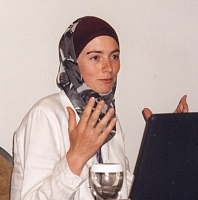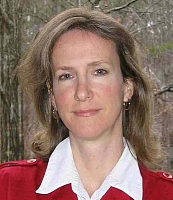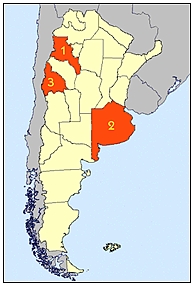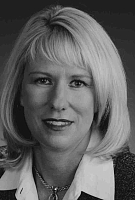|
JOINT COMMISSION WORKING GROUP ON
UNDER-REPRESENTED GROUPS IN SURVEYING
 Visit the Web site of the
FIG Working Group on Under-represented Groups in Surveying
Visit the Web site of the
FIG Working Group on Under-represented Groups in Surveying
 This Newsletter in -pdf-format
This Newsletter in -pdf-format
Contents
Why is Building Conservation Attractive
to Women?, by Ali Buxton, UK
Introducing Cathy Costarides, LS and the rise
of SurveyingZone.com, by Loyce Smith, USA
Strengths and Weaknesses of Postgraduate
Education in Argentine Surveying, by Dr Analía Isabel Argerich,
Argentina
Patricia D. Galloway: A Leader in U.S.
Engineering Activity, by Wendy J. W. Straight, LS, USA
Why is Building Conservation
Attractive to Women?
By Ali Buxton, UK

Ali Buxton during her presentation in Athens, FIG Working Week.
There is a perception that Building Conservation as a career is
different from the mainstream, and it appears to be more attractive to
women - at whatever level - than many other careers in the construction
industry.
The growth of women in the workforce generally (some 50%) is nowhere
near being matched within the construction industry as a whole - the CITB
(Construction Industry Training Board) placed it at around 8.6% in 2000
across all positions. The various industry and professional bodies are
actively supporting the need to attract women, with the CITB saying they
want a 10% year on year increase in participation, the RICS (The Royal
Institution of Chartered Surveyors) have their own Raising the Ratio
working group and the RIBA (Royal Institute of British Architecs) have
carried out research to find out "why women leave architecture."
The initiatives that are working towards change might have something to
learn from Building Conservation - while the shortage of skills is severe
- this area of work holds an attraction to women, not found elsewhere.
I work as an Historic Building Surveyor and as part of my final year
Building Surveying degree I carried out research into why building
conservation is attractive to women. My research shows that the majority
of women working in Building Conservation did not agree that men heavily
dominated their sector of the industry, whereas within other areas of the
construction industry men make up approximately 90% of the workforce.
I was able to conclude that women often perceived the construction
industry to be “cut-throat”, “egotistical” and “financially beneficial”,
whereas they thought Building Conservation required “patience”, “care” and
“attention to detail”.
Comments from some of the women who took part in the research suggested
that as Building Conservation is a relatively new profession there are
less ingrained attitudes regarding women working in a male dominated
profession. A second suggestion was that highly skilled crafts men and
women take much pride in their work and there is not the “foul mouthed”,
“tea breaking”, “Daily Sport reading” builders that can be found in the
trade sector of the construction industry. As a woman I know who I would
rather be around day in day out!
As part of the ‘Lets TWIST’ and ‘JIVE’ initiatives to encourage women
into construction and engineering, I get the chance to talk to women and
schoolgirls about my experience within the construction industry and
Building Conservation. Many of the girls I talk to have an interest in Art
and Design, History, Geography and Technology and once they have been
enlightened as to what I do and how much I enjoy it, I often get feedback
indicating lots of young girls wanting to take up Building Conservation.
My research shows that when male and female sixth form students are told
what Building Conservation is and what it involves 43% would consider a
career in it and 49% would be interested in talking part in a work
experience placement working with historic buildings. This positive result
was gained by simply removing the ‘Construction Industry’ from the
equation.
The shortage of people working in building conservation could be
reduced if more people were educated about the profession in a way
relevant to their skills and interests. As building conservation rarely
involves constructing anything, should it be labelled as part of the
construction industry when recruiting? Maybe it is time to stand on our
own two feet like Archaeology, which attracts many women. When I was
choosing my career I couldn’t see where my interest of Art and History
fitted into the construction industry, so I was put off from looking for a
career in this area, and I certainly never saw any building conservation
stands at any of the career fairs I attended!
Thousands of pounds can be spent giving the construction industry a
facelift to try and attract women, but a much cheaper option is to go in
via the back door. There are many other sectors within the construction
industry, especially on a professional level, that could benefit from
recruiting outside the stereo typed construction industry heading. Many of
the attributes that put women off entering the construction industry also
deter many men. Many of these factors are not evident in building
conservation but when access into conservation is through the construction
industry many potential recruits are put off.
With a growing need for people working in this sector, it is a perfect
time for building conservation to stand on its own two feet and get
recruiting for itself.
Contact: Ali Buxton, School of Environment and Development, Sheffield
Hallam University.
Email: alibuxton@hotmail.com
Introducing Cathy Costarides, LS
and the rise of SurveyingZone.com
By Loyce Smith, Professional Land Surveyor, USA

Cathy’s first memory of surveying, at about age 11, was holding the
“dummy” end of a long cold metal chain, while watching her father stomp
his way through a trash pile covered in kudzu. This tape was nothing like
the soft measuring tape she knew her mother had in her sewing basket; but
she knew the measuring principles had some similarity. She noticed that
her father kept his gaze toward the ground as though he was tracking an
animal. She thought at the time that her Dad had one strange and crazy
job. At first she saw no importance in this task he was performing and why
iron pins sticking out of the ground randomly seemed to appear at the end
of that chain. She did see layers of different colors of flagging on these
pins and wondered who put them there and why. Why were some of the pins
buried, and how did her father know exactly where to dig to find them? He
took time to explain that the property lines they were measuring were
invisible, which made her imagine being surrounded by all sorts of bizarre
lines too small to see.
When Cathy was not helping her father on the survey crew, her mother
encouraged spirited and energetic playtime - outside of course. After a
childhood of rough and tumble activity, Cathy and her sister were sent to
charm school in their teens. They envied their brothers, who got to stay
home. The sisters learned all the things young ladies are supposed to
know, but Cathy remained very much an incurable tomboy.
By age 17 in the late 70’s Cathy was working full time in the family
surveying practice. Charm school training went by the wayside when there
was field work to be done. She sometimes did not bother with makeup or a
fussy hairdo. In this position she had to do EVERYTHING. The various
duties included cleaning the office, running the rod, cutting line,
marking and flagging stakes, ordering supplies, running what seemed to be
millions of bluelines using what she calls a “glue sniffer’s dream” diazo
machine, getting the payroll out, paying the bills and the ubiquitous
“other duties as assigned”. In those days everything was handwritten or
typed from a manual typewriter. Cathy learned how to collect money from
mostly fifty something year old men, run punch cards through the card
reader, how to Leroy, sharpen machetes without cutting herself, andpound
truck loads of stakes into the hot Georgia clay.
She took a break from surveying for a little while to attend a business
college where she received a BBA in Marketing from Kennesaw State
University in 1986. During summers and breaks she kept surveying. When she
graduated, she realized that surveying would be her career and that she
wanted to learn more about it. She went back to school and received a BS
in Civil Engineering from Southern Polytechnic State University in 1989.
She says she really did not take many surveying courses because of the way
the school scheduled the classes. Most advanced surveying classes were
only offered once a year and she missed out on a few she would have liked
to take. However, she got an exposure to civil engineering and absolutely
loved it.
Cathy has co-owned C & C Land Surveyors with her husband, Taso since
1989. She was licensed as a surveyor in Georgia in 1992. She has worked on
a variety of projects and especially enjoyed it when they were completed.
She thinks it is tons of fun to operate a practice and great to write her
own paycheck. She admits that sometimes that sounds comforting when you’re
the only working on the weekend or a holiday.
Surveying is so intertwined with Cathy’s personal life that the day
before her first son was born, she hurried down to the county office to
get some subdivision plans approved for a grading permit. She knew that
was the only day she had for that particular errand and really felt the
pressure of a hard deadline. She got the permit that day and the baby is
now five.
The most demanding and unreasonably client Cathy has ever had was a
dream date compared to taking care of her two very rambunctious sons, so
she added house bouncer and mommy to her list of many titles. She spends
much of her time with her boys but still helps to manage the practice.
Recently she had to show her husband how to do a pipe run in AutoCAD LD
after not doing one in 5 years and it came right back to her. She found
that amazing, just like riding a bicycle after a long lapse.
Cathy is now engaged in developing what she hopes to be a
groundbreaking website for geomatic professionals called SurveyingZone.com.
Things have really changed since that day in the kudzu. Cathy thinks
computers are marvelous machines. There are still a lot of fifty something
year old men to collect money from, but now they’re more like
contemporaries, and not nearly as intimidating. She has found that working
with men for many years does interesting things to the female psyche;
sometimes distorting a girl’s self-image. Nevertheless, she finds the
quirks of men’s minds fascinating. She claims that if you’re around them
long enough (and almost exclusively) you start seeing the world through
their eyes. Given this small insight, she has learned that women are
considered wonderful, kind, and nurturing. Women are also said to smell
good and cry if you say something mean to them. Cathy has observed that
society takes these same notions and twists them into something very
different. She is thankful to all who helped her to see that truth.
Cathy is still learning, too. She is busy with the challenges of
understanding the concepts of observing GPS points, figuring out a new
data collector, finding seven different ways to create a polyline and
devising the best business strategy for saving time and money while
improving employee retention.
Cathy expresses amazement at how much to know about the art and science
of measuring our big beautiful planet. She expects to always have a
connection to land surveying and looks forward to what tomorrow brings.
About SurveyingZone.com
The site, initially launched in the fall of 2004, currently consists of
a Job Zone, which allows visitors to post or apply for surveying related
jobs, a Community page with bulletin board type postings through which
visitors can communicate with and learn from other members of the
surveying field, a Marketplace page set up like an online auction site
where visitors can buy and sell used surveying equipment, or locate
surveying equipment dealers. The Education component is currently under
development and will have information about degree programs, continuing
education, online learning and training on the latest software and tools
available.
For more information please visit
http://www.SurveyingZone.com or
email Cathy at
mail@surveyingzone.com
Strengths and Weaknesses of
Postgraduate Education in Argentine Surveying
By Dr Analía Isabel Argerich, Argentina
Educational Quality appears as a relative and complex concept that
takes for granted the idea of evaluating or assessing according to rules
or preset standards. For that reason, it has been pointed out that the
concept of quality when superior education is involved is a
multidimensional one, which embraces all of its functions and activities.
Therefore, its very nature demands an analysis of its component elements
in order to reach a clear understanding. The point seems to be that
evaluation pursues the reflexive analysis of functions and activities in
view of mechanisms leading to the institutional and academic improvement.
Wilson (1992) has related the teaching quality to the teachers’
qualifications by defining it as the ability to put into practice the most
appropriate curricula. His viewpoint stresses the importance to teachers’
formation, not only in the teaching methods and techniques, but also in
the subject he/she deals with. Thus, the postgraduate degree formation in
specific areas of Surveying, is nowadays presented in Argentina, as the
cornerstone leading to the formation of scientists and academicians who
may in turn, nurture research centers and university classrooms, with the
ability to create new knowledge and new technologies, and to feedback
postgraduate degree education. And it is this fourth level, the natural
and necessary base for the development of a coherent academic career,
since it facilitates the formation of a university culture which allows
institutional evaluation, not only at institutional level, but also as
teaching programs, research and community services are concerned.
Argentine Experience in Formation of Postgraduate Degree in Surveying
The Argentine experience in postgraduate degree education in Surveying
is a recent one. In this way, the Surveying Doctorate of the National
University of Catamarca, which began in the '90s, constitutes the first
Doctorate in its type -and so far the only one- in Latin America,
recognizing its antecedents in the German university programs of
Surveying. This proposal of maximum academic level whose main objectives
aim at deepening knowledge to reach excellent levels of training in the
chosen specialty and to acquire scientific formation to drive with success
investigations in surveying, it is exclusively directed to Surveying,
Geographer Engineers, and Geophysical Engineers whose degree studies are
equivalent to that of the career Engineering in Surveying of the National
University of Catamarca.
The duration of the Doctorate is variable, a 2 year-old minimum and a
maximum of 5, so that each candidate accredits the cycles of both
specialized and of complementary formation that will develop according to
his own choice of courses in the specialized area, in different
universities at home or abroad. The candidate should also pass an exam
demonstrating his mastering of two foreign languages, and to write a
Doctoral Thesis that means an original research contributing to a chosen
field of knowledge humanistic, scientific or technological: the project
for this theses should be approved by the Commission of Doctorate.
Finally, the candidate defends his Thesis openly in front of a board of
experts.
Since the creation of the Doctorate in Surveying, there has been a
registration of 36 candidates coming from different countries of Latin
American: Brazil, Uruguay and Guatemala. Although a significant percentage
abandoned or they deferred the program, four candidates have been awarded
the Doctor’s degree. Three of them reside in Argentina and the remaining
one in Brazil.
The main difficulties that have blocked the continuity of the career
reside in the lack of economic support for the development of and the
shortage of economic resources that prevails about in the region. In this
sense, the establishment of cooperation nets with other institutions
having a higher degree of scientific and technological development. On the
other hand, our country did not have a system of intermediate formation
between the Engineering in Surveying and its Doctorate. This situation led
authorities to reorganize the design of postgraduate degree careers such
as Diploma and Master degrees, as the Diploma in Valuations and in
Georeferencing that were created in 1996 by the National University of San
Juan and the Master in Geomatics that implements the National University
of La Plata.
Anyway, and it is fair to state it, an educational offer of
postgraduate degree courses exists in the country that is not only
dedicated to the graduate ones in Surveying, but it also includes a wide
range of areas of interest embrace within the professional field, as the
Doctorate of Geophysics implemented at the National University of Rosario
that has already awarded this degree to two surveyors and likewise it
should be pointed out that a reduced group of Surveyors has carried out or
they are carrying out postgraduate degree studies at the moment in other
countries.
Geographical Location of Postgraduate Degree Careers in Surveying

References:
1 – Province of Catamarca: Surveying Doctorate – National University of
Catamarca
2 – Province of Buenos Aires: Master in Geomatics - National University of
La Plata
3 – Province of San Juan: Diploma in Valuation and Diploma in
Georeferencing – National University of San Juan
Present Challenge
As of the last decade, some postgraduate degree proposals in areas of
interest of the Surveying have been developed in Argentina, and although
their history is very recent, they expect to meet the demands for highly
qualified human resources in the profession, with growing participation in
investigation so as to generate new knowledge and new technologies.
Nevertheless, the observed difficulties show different aspects that should
still be overcomes, as the scarce institutional support and the faulty
financing based on the criterion of self-financing of the postgraduate
degree careers. There is not doubt that the success of a national program
of academic, scientific and technological excellence, properly planned and
coordinated mainly depends on the convergence of three essential factors:
human resources, infrastructure and financing, the first two are highly
dependent on the last one.
The present challenge facing the postgraduate degree formation in
Surveying, consists in offering opportunities on equal terms with the aim
of increasing the number of highly qualified human resources to secure the
research in Surveying and feedback the postgraduate degree formation.
Roberto Ruiz Torrealba (1992) who was Academic authority of the
University of Venezuela, affirms that when the own University strengthens
the postgraduate degree formation, it begins to demand higher credentials
for the entrance to the educational and investigation staff, this
requirement contributes to the increase of the academic level and it
allows the recovery of the normal academic circuits.
Therefore, the challenge faced today by postgraduate education consists
in obtaining equality of opportunities and in widening -in the short term-
the horizon of highly-qualified human resources in order to strengthen
research on Surveying and contributing for academic excellence. The fourth
level, natural and necessary basis for the development of a coherent
academic career, facilitates the shaping of a university culture that
admits institutional evaluation, at the level of the institution as well
as at the levels of its programs in teaching, research and extension to
the community.
Contact: Dr. Analía Isabel Argerich, Universidad Nacional de Catamarca,
Argentina
Email: anargerich@arnet.com.ar
Patricia D. Galloway: A Leader in
U.S. Engineering Activity
By Wendy J. W. Straight, LS, USA

“I am proud to be a civil engineer. I am proud to have served as
your president. I am proud of our engineering heroes all around the world.”
In her parting words last September, at the close of her presidency of the
American Society of Civil Engineers (ASCE), Patricia D. Galloway,
P.E. summarized her term of office, a year in which she had consistently
promoted the civil engineering profession.
Galloway also encouraged ASCE members to view themselves as part of the
global engineering community. “I challenge each of you to think about
how we should move ahead in the area of globalization,” she told her
constituents, “and how we can truly become global leaders. If we are
successful in this respect, we will be able to make important
contributions in improving the quality of life for people around the
world.”
Earlier this year, a national report on science and engineering had
indicated an uncertain future for United States leadership in those
fields. Although jobs which require such training continue to grow, there
is a decline in the number of United States citizens who are training to
become scientists and engineers. During her presidency of ASCE, Galloway
encouraged American engineers to help brighten this bleak forecast.
“Today’s young people, especially girls, require role models and
mentors to give them the hands-on guidance and encouragement that will
help them consider an engineering career,” Galloway said. She then
announced a joint venture by ASCE, the American Association of Engineering
Societies, the Society of Women Engineers, and the National Academy of
Engineering, to develop an educational initiative to inspire young women
to choose engineering as a career.
The coalition has also reached out to a number of other engineering
organizations in America, because a primary goal of the program is to give
young students many hands-on activities, and to expose them to role
models. Additionally, the program will celebrate the accomplishments of
women in engineering,” Galloway explained. “We need to provide role
models and ensure that stories of success are told and retold,” she
said. “We must better prepare our teachers and university faculty
members, so that they not only impart information, but also inspire and
challenge their students.”
To begin the project, ASCE is launching the publication, “Women
Engineers: Extraordinary Stories of How They Changed Our World.”
Educational materials will be developed next, along with a television
documentary and national outreach programs. Support for the project
includes organizations which represent more than one million engineers
nationwide.
Deliverables designed for this project will meet the following goals:
(1) demonstrate to students from all backgrounds that engineering is an
exciting career path; (2) promote diversity within the engineering
profession; (3) motivate role models by celebrating the achievements of
women engineers; (4) increase public awareness about the importance of
engineering in everyday life.
Web initiatives, including virtual museums, help promote women’s role
in science and technology. Examples include (1)
www.girlgeeks.org (women in
computing); (2) www.engineergirl.org
(women in engineering; (3)
www.chemheritage.org/women_chemistry/ (women in chemistry); and (4)
www.ieee-virtual-museum.org
(women in electrical technologies).
American geomatics began as part of the engineering field. Therefore,
surveyors and mappers in the United States maintain close ties to ASCE.
American women in surveying have conducted recruitment activities since
1983, and the Society of Women Engineers has been doing the same since
1950. As Galloway completed her term as president of ASCE, she encouraged
ASCE members to offer their help with the education project by visiting
www.engineeringwomen.org.
All interested persons may assist, and may contact Galloway directly
through patnwg@aol.com.
|
Editor: Chair of the Joint Commission Working Group
on Under-represented Groups in Surveying
Ms. Gabriele Dasse,
Kleinfeld 22 a, D-21149
Hamburg, Germany
E-mail: g.dasse@gmx.de
1/05, month of issue:
January
© Copyright 2005 Gabriele Dasse.
Permission is granted to photocopy in limited quantity for educational
purposes.
Other requests to photocopy or otherwise reproduce material
in this newsletter should be addressed to the Editor.
|
|



























